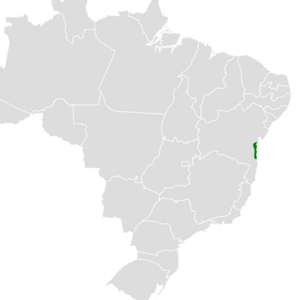Bahia tapaculo facts for kids
Quick facts for kids Bahia tapaculo |
|
|---|---|
 |
|
| Conservation status | |
| Scientific classification | |
| Genus: |
Eleoscytalopus
|
| Species: |
psychopompus
|
 |
|
| Synonyms | |
|
Scytalopus psychopompus |
|
The Bahia tapaculo (scientific name: Eleoscytalopus psychopompus) is a small bird that belongs to the Rhinocryptidae family. This special bird lives only in the lowland Atlantic forest of Bahia, Brazil. When a plant or animal lives only in one specific area, it is called endemic.
Contents
Understanding the Bahia Tapaculo
What is a Tapaculo?
Tapaculos are a group of small, secretive birds. They are known for their loud calls. They often live in dense undergrowth. This makes them quite hard to spot in the wild.
How Scientists Classify This Bird
For a long time, the Bahia tapaculo was thought to be part of the Scytalopus group of birds. Another bird, the white-breasted tapaculo, was also in that group. However, scientists later found out that these two birds are actually more closely related to a different type of bird called bristlefronts. This discovery led to them being placed in a new group called Eleoscytalopus.
Some people also wondered if the Bahia tapaculo was just a type of white-breasted tapaculo. But studies of their DNA showed that they are indeed different species.
What the Bahia Tapaculo Looks Like
Size and Weight
The Bahia tapaculo is about 11 centimeters (4.3 inches) long. That's roughly the length of a pen. One male bird weighed about 17.5 grams (0.6 ounces). A female bird weighed slightly more, around 18 grams (0.63 ounces).
Colors and Markings
This bird has a beautiful blue-gray color on its upper body. Its lower back, called the rump, is a reddish-brown color. The throat, chest, and belly of the Bahia tapaculo are white. Its sides and the area around its tail are chestnut brown. Unlike the similar white-breasted tapaculo, the Bahia tapaculo does not have stripes on its sides.
Where the Bahia Tapaculo Lives
Its Home in Brazil
The Bahia tapaculo is found in only a few areas in the eastern part of Bahia state in Brazil. It prefers to live in the lower parts of old, mature forests. These forests are usually found at low elevations, up to 50 meters (164 feet) above sea level.
Preferred Habitat
This bird likes to stay hidden in very thick plants and bushes. It often chooses places close to small streams. The dense cover helps it stay safe from predators and find food.
How the Bahia Tapaculo Behaves
Diet and Feeding Habits
Scientists still have a lot to learn about the Bahia tapaculo. For example, we don't know what it eats or how it finds its food. More research is needed to understand its diet.
Breeding Information
There isn't much information about how these birds raise their young. The only clue comes from two birds, a male and a female, collected in October 1983. They showed signs that they were ready to breed.
The Bird's Song
The Bahia tapaculo has a unique song. It is a long, trilling sound that can last up to four seconds. After the first one or two seconds, the song gets louder. You can listen to its song online [1].
Protecting the Bahia Tapaculo
Current Status
The IUCN (International Union for Conservation of Nature) has listed the Bahia tapaculo as an Endangered species. This means it faces a very high risk of becoming extinct in the wild.
Rediscovery and Threats
For a while, people worried that this bird might have disappeared forever. Luckily, it was rediscovered! It is now known to live in several municipalities in Bahia, including Igrapiúna, Una, Ilhéus, Maraú, Taperoá, and Valença.
Despite its rediscovery, the Bahia tapaculo is still in great danger. Its biggest threat is habitat loss. This happens when its forest home is cut down or destroyed for other uses, like farming or building. Protecting these forests is very important to help the Bahia tapaculo survive.


